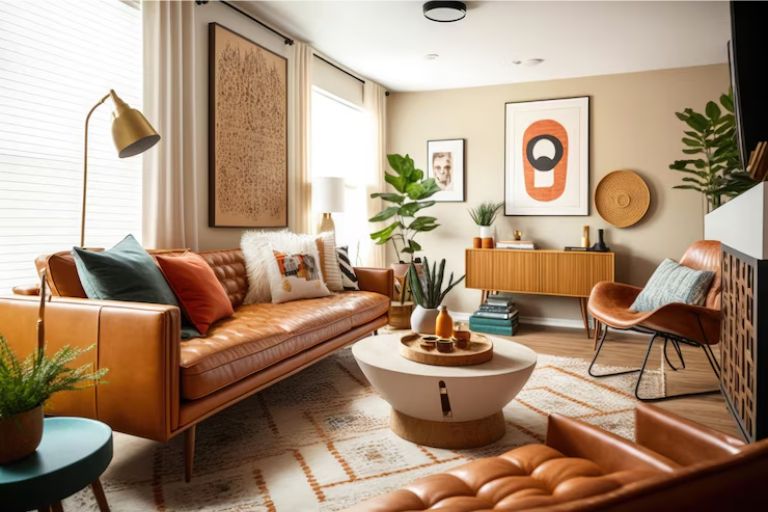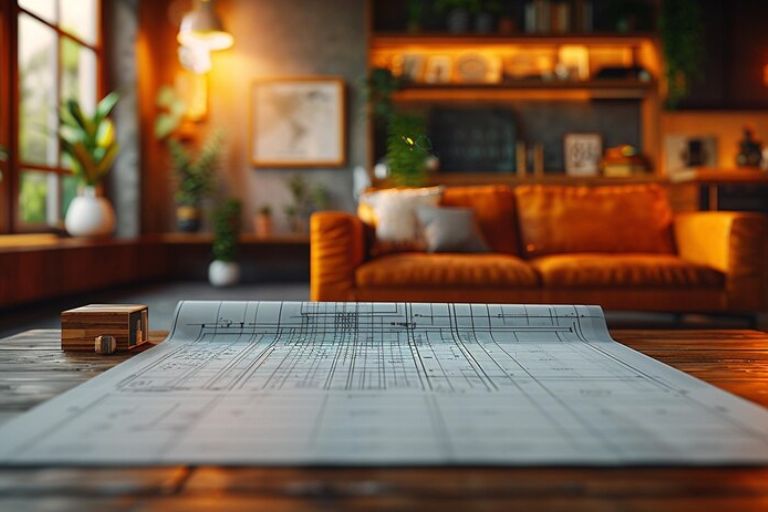Let’s talk about crafting spaces that not only look good but also do good for the planet!
Sustainable interior design is all about making choices that minimize our environmental footprint while maximizing style and comfort. Designers and owners have a duty to the planet because buildings contribute to almost 40% of carbon emissions.
In the field of interior design,
all designers must keep up with current trends, whether they are focusing on decoration, renovation, or architectural detailing. One of the most rapidly growing areas in the industry is sustainable or “green” interior design, which involves incorporating practices like rainwater collection and using eco-friendly materials like bamboo to create environmentally friendly spaces.
Although sustainable design is often associated with solar arrays and green roofs, interiors play a role in lowering a building’s carbon footprint. By selecting materials carefully, you can decrease embodied carbon levels and promote healthier indoor environments for occupants.
THE DEFINITION OF SUSTAINABILITY IN INTERIOR DESIGN
The International Journal of Sustainable Built Environment research indicates that sustainable interior design focuses on using aesthetic principles and strategies to offer worldwide benefits.
Interior designers play a significant role in the sustainability of homes and businesses, as they have the power to choose materials and products to determine the interaction with the living environment.
The 4 pillars of sustainability The concept of sustainability focuses on the conservation of resources, encompassing human, social, economic, and environmental aspects.
PRINCIPLES OF SUSTAINABLE INTERIOR DESIGN
Sustainable interior design is driven by principles focusing on environmental responsibility, human well-being, and resource efficiency, forming the foundation of its practice. The prime principles would be
- Resource Efficiency minimizing waste and maximizing durability to optimize resource use
- Biophilic Design for aesthetics and well-being to Incorporate nature-inspired elements
- Adaptability for reducing renovations, so that the Design spaces can adapt to the changing needs,
- Prioritizing occupant Health & Well-being through safe materials and comfort.
- Using energy-efficient systems to maximize natural light and ventilation.
- Supporting communities and reducing emissions by Sourcing materials locally
- Upcycling existing materials creatively to reduce waste.
- Considering the full lifecycle of materials to minimize the environmental impact.
- Involving the stakeholders in decisions and educating them on sustainability benefits.
- Following sustainability standards like LEED and WELL.
STRATEGIES TOWARDS AN ENVIRONMENTALLY CONSCIOUS TOMORROW:
Energy efficiency designing
Energy consumption plays a significant role in climate change, with buildings being a major source of greenhouse gas emissions due to their energy use. Architects and interior designers can enhance a building’s energy efficiency by decreasing the energy required for heating, lighting, and appliances, as well as incorporating renewable energy sources.
Preparing for low environmental impact
When considering sustainability, it is crucial to select materials and products with minimal environmental impact. Organic materials like wood, wool, and natural stone may seem like the best choice, but it is essential to remember the responsible treatment of natural resources. Opt for quickly renewable materials like fast-growing bamboo, extracted in an environmentally friendly manner. Look for labels, standards, and certifications that provide reliable information on product origins and assist in identifying eco-friendly options. For instance, an FSC label on wood products guarantees sustainable harvesting practices.
Materials and products need to be assessed for their environmental impact from extraction to disposal. Tools like the LCA aid designers in understanding a product’s environmental impact at different life cycle stages.
Optimizing waste generation
Interior designers hold significant influence in minimizing waste and carry a major obligation to practice sustainability. With finite resources on Earth, the practice of discarding items when they become outdated and buying new trendy ones is no longer acceptable.
Rather than throwing away functional items labeled as “outdated,” designers are encouraged to find innovative ways to repurpose them. Luckily, interior designers have the choice of using antique and vintage décor. Furniture and decorative pieces can be repurposed, refinished, or refurbished to give them a fresh look. For those who care about the environment, recycled materials can be used for tiles, carpets, fabrics, sinks, and counters.
Design for longevity and flexibility
Interior designers should take into account the longevity of materials to reduce excessive disposal of products. It is important to prioritize durability when selecting materials for high-traffic areas like flooring, to create timeless and long-lasting spaces. Opting for quality materials, classic design choices, and a focus on simplicity and functionality can help achieve a timeless look in interior design.
Over time, individuals mature and evolve, desiring environments to evolve alongside them to mirror these changes. In preparation for this, interior designers must assess the adaptability of spaces to accommodate the shifting requirements of users. Creating adaptable spaces is crucial for longevity, as it eliminates the necessity of complete demolition and renovation by enabling easy replacement or modification of elements within a room.
Striving for healthy environments
It is common for individuals to spend the majority of their time inside various types of buildings. Despite being often overlooked, focusing on the health of an indoor environment should be a primary concern for interior designers. Key factors to consider for creating healthy spaces include air quality, heating, ventilation, lighting, and acoustics.
Maximizing efficient use of space.
Effectively utilizing interior spaces can help reduce the size of a building, as well as the need for construction materials and resources. Micro-housing projects called “apartments,” are a popular solution in rapidly growing urban areas, typically sized at 300 square feet or less and including built-in features like a fridge and microwave. Certain developments have achieved LEED certification.
Planning for energy-efficient lighting
Smart interior design can utilize windows and skylights to make the most of natural light and reduce the reliance on artificial lighting. LEDs, halogens, and compact fluorescent bulbs are energy-efficient and have a longer lifespan when artificial lighting is necessary.
Using non-polluting products
There is a growing selection of non-toxic options on the market, including organic, hypoallergenic paint, untreated fibers, and wood.
Opting for energy-wise construction and design materials.
Interior designers can work with windows and doors that maximize energy efficiency, wood flooring that comes from rapidly renewable sources like-
- Reclaimed Wood
Reclaimed wood is simply wood created from old, repurposed materials. It is utilized in crafting coffee tables, rocking chairs, and flooring.
- Bamboo
Bamboo has a rapid growth rate of 1.5 inches per hour, making it a renewable option compared to other woods. Its ability to thrive in different terrains with minimal need for fertilizers or pesticides makes it a more eco-friendly and sustainable choice.
- Recycled Metal
Everyone has learned in school about the advantages of recycling for the environment. This also applies to recycling in interior design! Using recycled metal for furniture reduces the need for processing and resources, making it a more environmentally friendly option compared to non-renewable materials. Recycled metal can give furniture, like aluminum chairs, a stylish and contemporary appearance.
- Recycled Plastic
Who could have imagined that plastic, known as the most notorious material that doesn’t decompose, could be utilized in furnishing houses? Reused plastic can be transformed into rugs for both indoor and outdoor use.
- Jute Fibers
Most Indian homes own some jute bags. These bags can now be incorporated into home decor. Jute’s heat insulation properties make it ideal for creating rugs. Besides being environmentally friendly, jute adds a natural warmth to interiors and is cost-effective.
- Bio-glass
Bio-glass is frequently utilized in eco-friendly interior design due to its minimal environmental impact. It is renowned for its non-reactive characteristics and sleek appearance.
- Non-toxic paint
It might surprise you to learn that indoor air can be up to three times more polluted than outdoor air. The paints commonly found in homes are not only highly energy-intensive to produce, but also contain chemicals that continue emitting harmful compounds long after painting. Don’t worry, a solution is available for cleaner air!
By incorporating these sustainable interior design strategies into your projects, you can create spaces that are not only aesthetically pleasing but also environmentally responsible.
So, let’s design a brighter, greener future together!
We deliver, what we promise ~Concept space




Add Comment